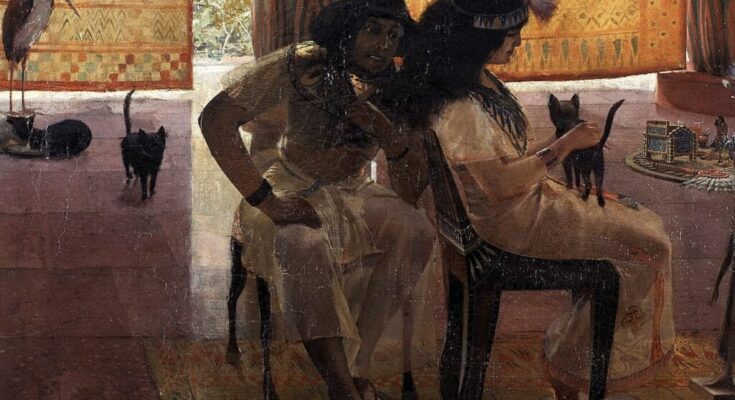Ancient Egyptians loved their cats to the point of worship, so when their beloved feline pet died, the whole family went to extreme depths of mourning, even shaving their eyebrows off.
The Egyptians came to admire felines for their complex, dual nature. They are graceful, gentle animals, but they can suddenly turn aggressive and vicious.
While in ancient times domesticated cats lived with humans for purely practical purposes, such as to rid the house and granary from vermin, for ancient Egyptians, they were a part of the family. In many cases, as archaeological findings show, they even mummified them when they died.
This is not because Egyptians believed felines were divine creatures but because they ascribed the traits and characteristics of cats to their gods.
Bastat is the best known deity ascribed with feline characteristics and was depicted as a cat from the second millennium BC onwards. She was the goddess of the home, fertility, childbirth, and, yes, cats themselves. Initially, she was depicted as a lioness but was later changed to a cat—or a half cat-half woman figure.
The feline deity had the characteristics of a real cat. She was motherly and protective, but protected her kittens like a mother and could swiftly become vicious if she sensed they were threatened.
There are many representations of Bastat in Egyptian art. Some sculptures portray her as a seated cat or a cat feeding her kittens. Other works of art include dedicatory inscriptions addressed to Bastat. The offerings were from people who asked the goddess to grant them good health or help them bear children.

Egyptians did not name their cats
Even though they loved their cats, many ancient Egyptians did not name them. They referred to their cats by the Egyptian word for cat, “miu,” meaning “he or she that meows.”
In short, although they didn’t do well with names, the ancient Egyptians literally worshiped cats and viewed them—along with other animals—as symbols of the divine qualities of the gods. They admired felines both for their hunting skills and for the way they raised their young.
Ancient Egyptians were so devoted to their cats, in fact, that they would shave their eyebrows when their cats died. The mourning period came to an end when their eyebrows grew back.
Keeping a cat in the house was considered a way of attracting good luck and warding off evil spirits, and the death of a cat was considered a significant loss. Many Egyptians went so far as to mummify them.
Royals treated their cats as royalty, too. They would allow their cats to eat from their plate and decorate them with gold jewelry.
Sekhmet was a lion goddess of war who defended Ra, the sun god, from his enemies. She represented the other half of the most revered qualities of cats. Statues of these divine felines are in museum collections to this day.
Cats in Egyptian mythology
Sekhmet and Bastet are prominent in Egyptian mythology. The terrifying and nurturing dualism of feline goddesses is most commonly represented by these two. Yet, there were other daughters of the Sun seen as goddesses. For instance, Hathor-Tefnut is described in the Myth of the Eye of the Sun in Philae as the one who “rages like Sekhmet and is friendly like Bastet.”
These goddesses were seen by the Egyptians as one fierce, feline, female force that carried the power of the sun’s fire to destroy, burn, and scratch all who stood in her way. However, it turned into a nurturing divinity when pacified.
Ancient Egyptians also liked to mummify their cats, as well as other animals. Each mummified animal was linked to a specific god and people made offerings to that god in hopes of favors or a sign of gratitude. They dedicated cat mummies to the nurturing and dangerous goddess Bastet, and huge numbers of cat mummies have been found in the city of Delta, the center of worship of the goddess.
The Egyptian mummified cats were placed in rectangular or cat-shaped coffins or otherwise wrapped in linen and painted to resemble a cat.



